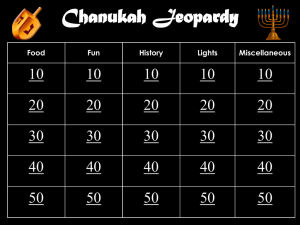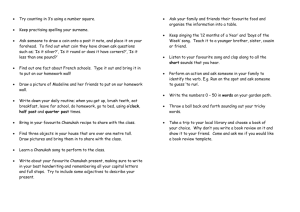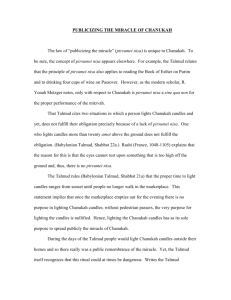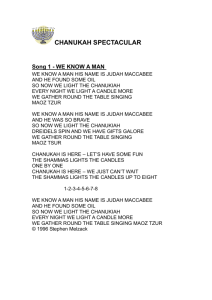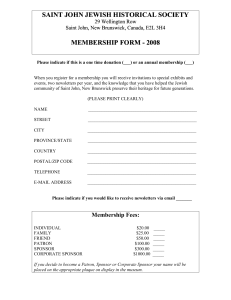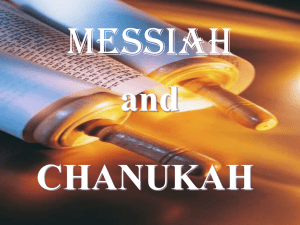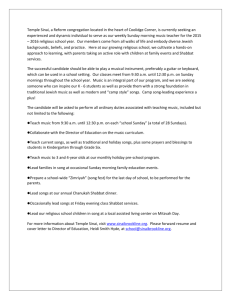Chanukah Q & A full sheet.indd
advertisement
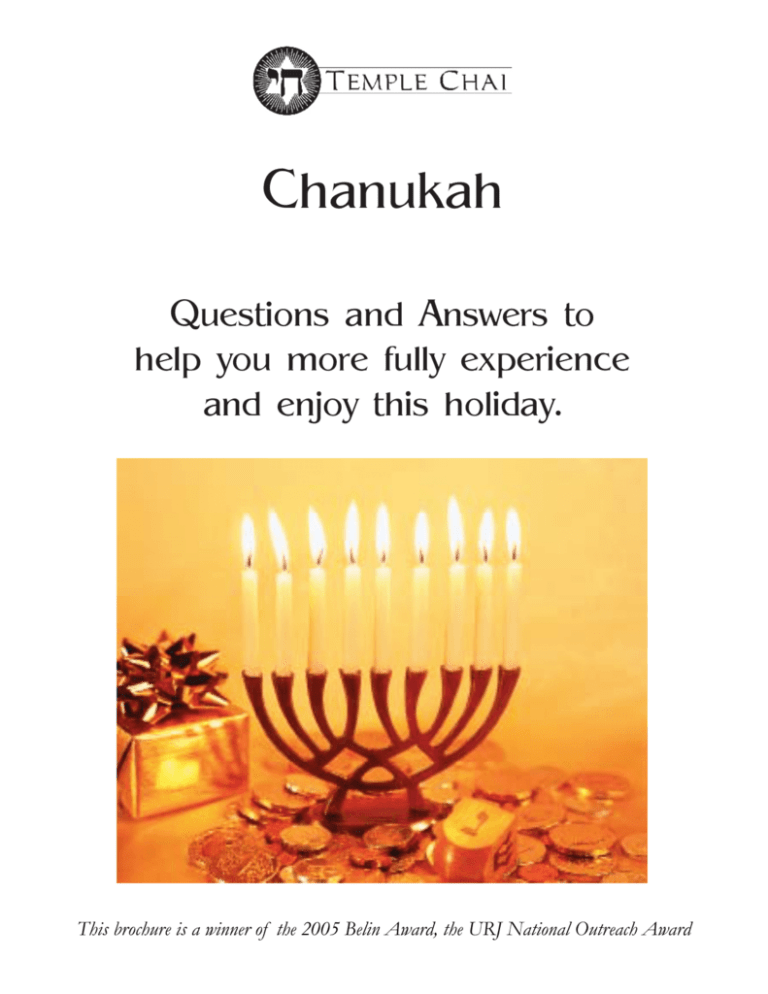
Chanukah Questions and Answers to help you more fully experience and enjoy this holiday. This brochure is a winner of the 2005 Belin Award, the URJ National Outreach Award What does the word Chanukah mean? The most frequent translation of Chanukah is dedication – that is, we remember the rededication of the temple. Why is Chanukah celebrated? Chanukah marks the deliverance of the Jews of Palestine from the oppression of the Syrian-Greeks in the second century B.C.E. (Before the Common Era). The Greeks attempted to impose heathen practices upon the Jewish population, but Judah Maccabee and his four brothers, sons of Mattathias the Priest, all members of the Hasmonean family, led a rebellion against them. The revolt reached its climax when King Antiochus IV of Syria prohibited the observance of sacred Jewish practices, including circumcision, Temple ritual, Sabbath observance, and the study of Torah. The decisive insult was the conversion of the Temple into a pagan shrine. In the year 165 B.C.E., the rebels succeeded in defeating the Syrian armies, after which the Temple was cleansed and rededicated. According to some traditions, the Maccabees built a new altar and/or Menorah(candelabrum) since the old ones were profaned by the Syrians. Thus, Chanukah marks the dedication specifically of these objects in the temple. Why does the celebration of Chanukah last for eight days? There are many reasons why we celebrate Chanukah for eight days. Here are some of the most popular. • The Talmud explains that when the Syrian-Greeks captured the Temple, they desecrated all the jugs of oil that the High Priest had prepared for lighting the Temple Menorah. After much searching, only one small undefiled jug still bearing the unbroken seal of the High Priest could be found. This cruse contained only enough oil to burn in the Menorah for one day. Nevertheless, the High Priest kindled the Menorah and a miracle happened – the Menorah flame continued to burn for eight days. To commemorate the event, it was decided that the holiday would be observed annually by kindling lights for eight days and Chanukah became known as the Feast (or Festival) of Lights. • The Macabees divided one night’s oil into eight portions, and miraculously, each portion lasted an entire night. • Seven days commemorate the miracle of the oil, and one day commemorates the miracle that a few weak Jewish soldiers defeated the mighty Greek legions. • The world was created in seven days. There are seven notes in the musical scale, seven days of the week. Therefore, the number seven represents the physical world that we can touch and smell and feel. The number eight, on the other hand, transcends the natural world. That’s why the miraculous days of Chanukah are eight. Though eight emanates from beyond our senses, your soul can still reach out and be touched by its force. • On a deeper level, the days of Chanukah are eight days of transcendence. Days of opportunity to look both within ourselves and beyond, to sense that there is far more to our existence than the world of nature could ever contain. Is gift giving really a part of Chanukah? Presents are wonderful – to give and to receive. Traditionally, Jewish children are given daily gifts throughout the holiday. By making it into a fun-filled occasion, many parents hope that their children will not feel that they are missing out on Christmas trees and gifts brought by Santa. But Chanukah is primarily not a season of giving but a season of growing. It is the opportunity to discover so much more – to acquire fresh insights into Jewish life and a bold new inspiration for living. It’s just that gifts don’t have any particular significance on Chanukah. In fact, if no one gives or receives even one present on Chanukah, they have not omitted anything central to the holiday. When is Chanukah celebrated? The first night of Chanukah is celebrated on the 25th of Kislev. Because of vagaries of the Jewish lunar calendar, Chanukah can begin anywhere between the end of November and the end of December. Why does Chanukah fall on the 25th of Kislev? Some commentators play on the Hebrew word by dividing it in half: chanu-kah – that is, they rested (chanu) on the 25th day (the numerical value of the letters of k and h equal 25). The Maccabees ceased fighting on the 25th of Kislev, and thus Chanukah marks their victory over the Syrians. What is the difference between a Menorah and a Chanukiah? A Menorah is a candelabrum that usually holds a total of seven candles, whereas a Chanukiah has room for nine candles: eight candles and a Shamash (a helper candle) that is usually at a different height then the other eight candles. What is the ninth candle called and what is its special use? The ninth candle is called the Shamash. It is used to light the other eight since the Chanukiah lights may not be used for practical purposes (one should not use its light for reading, moving about a room, etc.). Do we place the Chanukiah in a special place? To best publicize the miracle, the Chanukiah is ideally lit outside the doorway of your house, on the left side when entering. If this is not practical, then the Chanukiah should be lit in a window facing the public thoroughfare. Someone who lives on an upper floor should light it in a window. If for some reason the Chanukiah cannot be lit in a window, it may be lit inside the house on a table; this at least fulfills the mitzvah (commandment)of publicizing the miracle for the members of the household. Since the mitzvah occurs at the actual moment of lighting, the Chanukiah must be lit in a proper place. Moving the Chanukiah to a proper place after lighting does not fulfill the mitzvah. What is the correct way to put in the candles and to light them? Candles are put in from right to left, but they are kindled from left to right to pay honor to the newer object first. This also gives equal importance to the left and right showing that God’s presence is everywhere. On the first night, one would place a candle on the far right, and light it with the Shamash. On the second night, one would place two candles on the far right, but light the newest one first, and work backwards. What do I do if the Shamash goes out? Relight it, but not from the flame of one of the Chanukah candles. Use a match. When does one light the Chanukiah? The Chanukiah should preferably be lit immediately at nightfall. It is best to wait, however, until all the members of the household are present. This adds to the family atmosphere and also maximizes the mitzvah of publicizing the miracle. However, the Chanukiah can be lit (and the blessings said) late into the night, as long as people are still awake. On Friday evening, the Chanukiah should be lit first, then Shabbat candles (because when Shabbat candles are lit, the lighting symbolizes the end of the work week, and lighting candles is considered work). On Saturday evening, the Chanukiah is lit after Shabbat is over. How long should the candles burn? The candle should contain sufficient oil (or wax) at the time of lighting to burn until at least 30 minutes after the stars come out. In the event that the light is extinguished before the prescribed time, it is proper to relight (without a new blessing). However, one is not obligated to relight; one has fulfilled the mitzvah with the original lighting. Can we use an electric Chanukiah? According to nearly all authorities, an electrified Chanukiah may not be used to fulfill the mitzvah of kindling the Chanukah lights. While electric bulbs undoubtedly give off light, the filaments are not considered a flame. Moreover, a requisite amount of fuel must be available when the lights are kindled. An electric Chanukiah depends on continuous generation of power to remain lit. Thus, the act of kindling in itself is insufficient to cause the lamp to burn for the prescribed period of time. Since the Halachic (law) principle governing the Chanukiah is that kindling constitutes the performance of the mitzvah, turning on an electric light would not fulfill the commandment. What is the difference between using the lights on Shabbat and Chanukah? The lights for Shabbat can be used for practical purposes, such as lighting a room. The candles for Chanukah can only be decorative. Therefore, one should not turn the lights of a room off when lighting the Chanukiah, making it possible for the lights to be used for practical purpose. Why are there three blessings said on the first night of Chanukah? The first two blessings recited over the candles on the first night of Chanukah refer specifically to the kindling of the lights and the miracle of Chanukah. The third blessing, called Shehecheyanu, is recited on the first night of all holidays. It expresses our gratitude for being alive and well and having reached this season of rededication. What are the candle blessings? Every night during Chanukah, when the candles are lit, these are the prayers that are recited – light the Shamash, say the first two prayers, then light the other candles with the Shamash. Ba-ruch ata A-do-nai E-lo-hei-nu, me-lech ha-o-lam, a-sher ki-de-sha-nu be-mits-vo-tav, ve-tsi-va-nu le-had-lik neir shel Chan-nu-kah. Blessed are you Adonai our God, Ruler of the universe, who has made us holy through the commandments and who has commanded us regarding the lighting of the Chanukah candles. Ba-ruch ata A-do-nai E-lo-hei-nu, la-vo-tei-nu ba-ya-mim ha-heim baz-man ha-zeh. me-lech ha-o-lam, she-a-sa ni-sim Blessed are you Adonai our God, Ruler of the universe, who made miracles for our ancestors in those days. After the candles are lit, on the first night of Chanukah, this prayer is also recited: Ba-ruch ata A-do-nai E-lo-hei-nu, me-lech ha-o-lam, she-he-che-ya-nu ve-ki-ya-ma-nu ve-hi-gi-ya-nu laz-man ha-zeh. Blessed are you Adonai our God, Ruler of the universe, who created us, sustains us, and who has brought us to this season. (Bold denotes syllabic emphasis.) What are some different ways that you can enhance the experience of the lighting of the candles? Dedicate each of the nights to someone in your family who is no longer living. You can reminisce about this person Each of the eight nights a friend or family member could share a past Chanukah experience Each of the eight nights a friend or family member could discuss how they can rededicate themselves to a cause or some important change in their life. You could discuss a different Jewish value and how each member of the family demonstrates these values: 1. Bal Tashchit: not being wasteful 2. Tza’ar Ba’alei Chayim: being kind to animals 3. Hachanasat Orchim: welcoming strangers or guest to your home 4. Kibud Av Va’em: honoring father and mother 5. Kibud Z’kaynim: honoring the elderly 6. Tzedakah: doing righteous acts, or showing kindness to others 7. Talmud/Torah: Jewish learning 8. Nedarim: keeping one’s word Is Chanukah an important holiday? Technically, no! Chanukah is one of the minor holidays in the Jewish calender. There are many people for whom Chanukah is the most celebrated time of the year. Perhaps this is because of Chanukah’s proximity to other non-Jewish holidays.Here is a story from the Sefat Emet (Rabbi Yehudah Aryeh Leib Alter of Ger of Warsaw, Poland, 1847-1905, Chassidic leader and Talmudist) that helps us to understand another reason why Chanukah has gained such importance in our era. Wicks and oils that are not fit for burning as Shabbat candles, because they don’t burn well, are nevertheless usable on Chanukah. Each letter of the Hebrew word for soul, nefesh, stands for a component of the candle: ner (flame), p’tilah (wick), and shemen (oil). Those Jewish souls that don’t burn so well – that are not aligned well with their Jewish identity – all during the year on Shabbat, are, due to the special power of the lights, able to burn brightly on Chanukah. For on Chanukah, perhaps more than any other time of year, one is able to get in touch with his/her Jewish identity. Why do Jews eat fried foods at Chanukah? Because the Chanukah miracle concerned oil, all the preferred holiday foods are fried in oil. Among American Jews, the latke, a pancake made of potatoes and onions fried in oil, is the food most associated with Chanukah. In Israel, the most popular Chanukah delicacy is the sufganiah, a fried jelly doughnut. Why is the word Chanukah spelled so many different ways. Channukah, Chanukah, Hanukkah, and Chanuka – these are all variations in transliteration spelling of the Hebrew word. There are different systems of transliteration, and there are those who prefer one over another. What is a dreidel? A dreidel is a four-sided top with a different Hebrew letter on each side. It is used to play a popular children’s game. The Hebrew word sevivon is derived from the Hebrew root meaning to turn. In Yiddish, such a top is called a dreidel. According to an old legend, the Chanukah top, dreidel, was invented during the time of the Maccabees. Antiochus forbade the study of Torah. Nevertheless, people gathered in small groups and studied the Torah secretly and by heart. If soldiers approached, the group scattered. Another means they used to escape detection was the dreidel game. The dreidel lay on the table. At the lookouts warning, the students spun the top. When the enemy arrived, all they could see was Jews playing an innocent game. Thus, according to tradition, the dreidel saved many lives. What are the letters on a dreidel? Today’s dreidel bears the letters Nun (b), Gimel (d), Hay (v), Shin (a). They stand for Nes Gadol Hayah Sham, a great miracle happened there. What makes a dreidel used in Israel different from those used outside Israel? The letters are different. Outside of Israel the letters refer to a great miracle happened there. However, in the land of Israel they stand for a great miracle happened here! What are the rules for playing dreidel? Bets are taken on what letter will be showing when the dreidel stops spinning. You may bet with Chanukah gelt, pennies, M&M’s, or paper clips. It’s the fun that counts. For each spin, if it stops on the nun, no one wins and the next player spins; on the gimel, the spinner takes the pot; on the hay, the spinner takes half the pot; and on the shin, one is put into the pot. Recipes Latkes Recipe courtesy of the URJ Jewish Parent Page (http://urj.org/educate/parent/ archive.shtml) Blend: 4 large grated potatoes (you may use a food processor) 1 medium onion, also grated 3 Tbsp. matzah meal or flour 3 eggs 1 tsp. salt 1/4 tsp. white pepper Heat a frying pan or skillet, 1/8 -1/4 full of cooking oil. Drop spoonfuls of the potato mixture in the heated oil, browning on both sides. Serve with sour cream and/or applesauce. The latkes can be made in advance and frozen. Prepare as directed and freeze on cookie sheets. When frozen, pack in plastic bags. To serve, place frozen latkes in one layer on a cookie sheet and reheat at 375 degrees for 10-15 minutes until heated through. Baked Latkes (for those who choose not to eat fried foods) Recipe courtesy Barbara Mark Dreyfuss In a food processor, grate: 4 medium potatoes 1 large onion 1 clove garlic 1 egg salt and pepper to taste Place in greased Teflon muffin tins. Only put in enough to cover the bottom. Bake at 400 degrees until brown (about 1/2 hour). Let cool for 15 minutes. Remove from muffin tins, carefully loosening the edges first. Serve immediately, refrigerate, or freeze and reheat at 350 degrees on a cookie sheet until heated through. Makes 2-3 dozen. Vocabulary Chanukiah: this is the correct name for the Chanukah Menorah. Gelt: Yiddish for money. Sometimes money is given as a gift to the children at Chanukah time. Latkes: potato pancakes fried in oil to remind us of the oil lasting 8 days in the holy Temple. Maccabee: means hammer. Our hero Judah was called the Maccabee. Shamash: the helper candle, or servant, that is always lit first, and then lights the other candles. Sufganiah (singular) or Sufganiot (plural): Jelly donuts traditionally eaten at Chanukah, because they are made in oil. Sevivon: Hebrew for dreidel, a four-sided spinning top with a different Hebrew letter on each side. This brochure was created by Temple Chai clergy and congregants under the loving guidance of Toni Dusik. Temple Chai - A Caring Community Rabbi Mari Chernow - Senior Rabbi Rabbi Bonnie Koppell Rabbi Jake Singer-Beilin Rabbi Emeritus William C. Berk Cantor Emerita Sharona Feller 4645 E. Marilyn Road Phoenix, Arizona 85032 If you would like information about Temple Chai please contact us at 602-971-1234 or templechai@templechai.com or visit us at www.templechai.com. revised 6.19.2012
